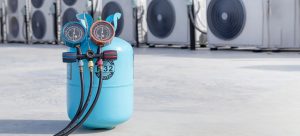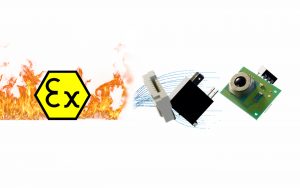By Samira Amani, Strategic Marketing Manager Automation, Omron Electronic Components Europe B.V.
As the world takes steps to safeguard the planet from a climate calamity, new hazards demand tighter regulations in applications such as industrial and consumer refrigeration, vending machines, and heating systems such as heat pumps and hydrogen boilers. In consequence, associated measurement and control devices and the components within them also face new applications and regulations.
Domestic and industrial refrigerators, vending machines, and heat pumps like air conditioning units rely on refrigerants. It is well-known that older refrigerants compromise the atmosphere. CFCs are notorious as destroyers of the ozone layer, and subsequent alternatives still have the potential to accelerate global warming – not to mention the further damaging effects on humans and the broader ecosphere.
Being more specific, a refrigerant is a working fluid used in the refrigeration cycle of air conditioning systems and heat pumps, where in most cases they undergo a repeated phase transition from a liquid to a gas and back again. Refrigerants are heavily regulated due to their toxicity, flammability, and the contribution of CFC and HCFC refrigerants to ozone depletion and that of HFC refrigerants to climate change.
Low-carbon systems are an obvious solution, giving way to new, environmentally friendly, refrigerants. The issue is that refrigerants with low ozone depletion potential (ODP) and the lowest Global Warming Potential (GWP) brings hazards of their own. In fact, low GWP refrigerants are highly flammable and consequently Gas Explosion proof design is mandatory. ATEX approved components could be a good solution to simplify the design and meet safety regulations for refrigeration, vending machines and heat pumps.
The issue with Heat Pumps
The world is beginning to phase out its use of fossil gas boilers in favour of heat pumps and alternative fuels. This brings-in new challenges with the need to identify solutions that mitigate the impact of global warming. whilst ensuring safety of heating and cooling plant. Further, our need to reduce reliance of fossil fuels is highlighted by recent volatility of global gas prices.
In Europe, the REPowerEU Plan has the further aim of phasing-out our dependency on fossil fuels. Reducing the carbon footprint will protect consumers as well as the atmosphere. These goals are underpinned by three pledges: to accelerate the transition to clean energy, diversify energy resources and reduce consumption overall.
To achieve these goals, gas boilers are going to be limited by EU Community policy Repower Plan, with further investments expected on solar and renewable energies. In particular, the European Union should aim at doubling the current deployment rate of individual heat pumps, resulting in a cumulative ten million units over the next five years. Extending these ambitions, REPowerEU ramps-up the schedule to a target of twenty million heat pumps installed by 2026 and close to sixty million by 2030.
 Following that, the German government has declared a new heating strategy focusing on district solutions with a mandate to make heat pumps mandatory as of January 2025. The Netherlands wants hybrid heat pumps to become standard when existing boilers are replaced and is making heat pumps will become mandatory from 2026. Britain has declared to target 600,000 heat pumps annually by 2028 and will be banning the installation of gas boilers in new-build properties from 2025. France has pledged to end government subsidies for the installation of new residential gas heaters and boost support for renewable energy heating, whilst Italy’s government has also declared their intention to prohibit residential gas heaters from 2029.
Following that, the German government has declared a new heating strategy focusing on district solutions with a mandate to make heat pumps mandatory as of January 2025. The Netherlands wants hybrid heat pumps to become standard when existing boilers are replaced and is making heat pumps will become mandatory from 2026. Britain has declared to target 600,000 heat pumps annually by 2028 and will be banning the installation of gas boilers in new-build properties from 2025. France has pledged to end government subsidies for the installation of new residential gas heaters and boost support for renewable energy heating, whilst Italy’s government has also declared their intention to prohibit residential gas heaters from 2029.
If these targets are achieved, fossil fuel use will be greatly reduced but the use of potentially damaging refrigerants will expand greatly as new heat pumps add to the existing demand for them from air conditioning and refrigeration. Clearly, it is essential to transition to low GWP refrigerants, which will entail moving to flammable gas explosion-proof design for all forms of heat pumps and refrigeration.
Standards for safety
The American Society of Heating, Refrigerating and Air-conditioning Engineering standard (ASHRAE) classifies refrigerants by hazard based on toxicity and flammability. Common non-polluting refrigerants such as R290 (propane), R1270 (propene) and R600a (isobutane) present zero ODP and low GWP ratings. However, they are rated to A3 standard, i.e., highly flammable. This means that fresh solutions are required for the components used in the design of heat pumps, air conditioning and refrigeration systems.
These considerations are even more applicable in the case of extremely flammable hydrogen boilers.
A potentially explosive atmosphere exists when a mixture of air gases, vapours, mists, or dusts combine in a way that can ignite under certain operating conditions. Across Europe the equipment and protective systems intended for use in potentially explosive atmospheres (ATEX) cover a range of products, including those used on fixed offshore platforms, petrochemical plants, mines, and flour mills, amongst others.
Explosion-proof relays, switches and similar devices come under the regulations of IEC60335-2-40 “Particular requirements for electrical heat pumps”. With air conditioners and dehumidifiers, the IEC 60730 / UL508 regulations expand applications for flammable refrigerants such as R290.
When it comes to real life usage, specific regulations apply to varying types of applications, from transport refrigerators, through chillers and air conditioning, to heat pumps and hydrogen boilers. This in turn, makes it necessary to develop fresh solutions that deliver protection whilst addressing market needs.
Sealed standard relays go explosion-proof
Amongst the early gains are the certifications of sealed and unsealed relays that have already gained approval to VDE IEC60079-15.
Here is one example. Omron’s G5NB is a miniature relay with 1-pole 5A/7A switching capability and 10kV impulse withstand voltage. Its highly efficient magnetic circuit provides high sensitivity of 200mW. This standard model conforms to UL/CSA/VDE standards and satisfies EN61010 reinforced insulation requirements.
 The G5Q miniature power relay is a single-pole component with 10A switching capacity and excellent switching performance for a variety of loads. It is small yet provides 8kV impulse withstand voltage (between coil and contacts). Low coil power consumption.
The G5Q miniature power relay is a single-pole component with 10A switching capacity and excellent switching performance for a variety of loads. It is small yet provides 8kV impulse withstand voltage (between coil and contacts). Low coil power consumption.
G2RL is a low-profile PCB power relay with 15.7 mm height, ideal for incorporation in miniature types of equipment. A wide variety of single-pole, double-pole, high-capacity (16 A) type, and high-sensitivity type (250mW) relays are available. G2RL satisfies ambient operating temperature requirements of 85°C and 105°C (-CV Model). Clearance and creepage distance: 8 mm / 8 mm min.
Low power consumption of the G5NB and G5Q’s ensures less heat is generated and this makes them ideal for high-efficiency operations. The G5NB and G5Q relays can be used in a wide range of consumer, commercial and industrial applications with explosion-proof, glow wire, high witching and high inrush type relays.
G5NB, G5Q and G2RL relays are approved for use with the increasingly hazardous situations involving hazardous fuels and refrigerants. VDE Explosion protection proofing to IEC/EN60079-15 is provided for both sealed and unsealed devices. with further approvals ongoing on motor loads. Additional approvals include VDE Glow Wire EN60335-1 and IEC/EN 60335-1 conformed. (-HA Model).
Miniature relays enter the fold
Alongside sealed standard relays, the miniature power relays like G6RN provide 8A switching 250VAC with a low-profile height of 15 mm. It also features high sensitivity with 220mW power consumption, high insulation with an insulation distance of 8 mm and impulse withstand voltage of 10kV between coil and contacts. G6RN satisfies the ambient operating temperature requirement of 85°C and the standard model conforms to VDE standards. Under development, the G6RN relay family will introduce an unsealed model –EL1, and its sealed counterpart –EL2. Both will carry approval to VDE Explosion protection proof IEC/EN6007915 and VDE Glow Wire EN60335-1 standards.
Sealed Microswitches
New versions of ultra-subminiature basic switches sealed to IP67 will also prove ideal for safe operation in proximity with highly flammable fluids. Models with sliding contact construction feature a long stroke and provide high reliability along with high insulation performance. Omron sealed microswitches are available for signal current up to 5A depending on the size, while all models can be provided with molded lead wires.
MEMS sensors keep air flowing
Monitoring air flow and air pressure ensures the correct and optimal operation of heat pumps, refrigeration plant and air conditioning systems, enhancing combustion efficiency in boilers, and supplying feedback control of air conditioning by measuring the amount of air and amount of ventilation.
High accuracy D6F-PH pressure sensors and 2SMPP gauge pressure sensor support the diverse needs of air flow measurements. They could also be used for clogged filter detection and support predictive maintenance solutions. Velocity-type D6F-V and D6F-W sensors save energy with airflow sensing, whilst optimizing air conditioning control without sacrificing quality.
Conclusion
The threat of global warming, together with the imperative of eradication fossil fuel use brings in new challenges. The world needs to find solutions that mitigate the impact of global warming, whilst ensuring safety of heating and cooling plant. Measurement and control devices are addressing the challenge of new applications and regulations.
At OMRON, we are committed to developing and promoting technologies that conserve resources and the environment. These will include ATEX-compliant relays, sealed switches, and new types of sensors.







Recent Comments